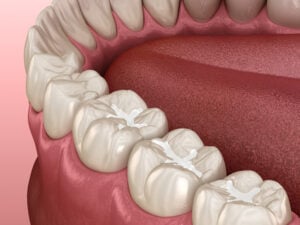Fixing a Broken Tooth




In this article
A broken tooth or fractured tooth can feel distressing and anxiety-inducing. But the good news is that a fractured tooth is still salvageable.
A quick dental treatment can effectively repair a broken tooth and prevent costly complications. Let's walk through how dentists classify tooth fractures, immediate relief steps you can take at home, and which professional treatments offer lasting solutions.

How Do Dentists Classify a Broken Tooth?
Understanding the type of cracked tooth you have determines how urgently it needs repair and how much you’ll likely pay.
Dentists identify fractures in five main categories:
Dentists use visual exams, dental x-rays, and special lights (transillumination) to diagnose the severity and depth of the fracture accurately.
Treatment for a broken tooth will depend on the size and location of the crack or break.
Here are the seven most common dental procedures used to repair a broken tooth:
If the tooth’s crack extends below the gum line, the tooth cannot be saved and will need to be extracted (removed).
Extraction is usually the only option when the crack is vertical, below the gum line, involves the roots, and when pieces are mobile.
After the tooth is extracted, a dental implant is surgically inserted into the jawbone. After the site heals, a crown, bridge, or denture is attached.
A dentist can repair the damage with a dental filling if only a small piece of enamel has chipped off. Dental fillings can be made of a white composite resin or silver amalgam (mercury mixed with silver, tin, zinc, and copper).

Fillings close the hole and restore tooth function. If a tooth is missing a large portion, a dental inlay can replace the missing part of the tooth.
This restoration is often stronger and more durable than a dental filling. If the chip is on the front tooth or visible when smiling, the dentist will likely use a blue LED curing light to bond a tooth-colored composite resin to the tooth's surface.
If the tooth's damage is only a small chip, a dentist can correct the issue by reshaping the tooth or smoothing and polishing the affected area.
Tooth reshaping removes small amounts of enamel from the tooth's surface. When done correctly, the procedure can improve the tooth's appearance and make it more symmetrical.
Dental veneers may be recommended if the chip is small and only causes cosmetic damage. It’s a layer of porcelain or composite resin covering a natural tooth.

Veneers can make a broken front tooth appear whole and healthy when placed over it. To apply a veneer, the dentist will first remove enamel from the tooth's surface.
Then they will make impressions and send them to a dental laboratory. After the veneer is made, the dentist will place it over the tooth at a later appointment.
A large fracture involving multiple tooth cusps may require a crown. A crown is a cover or "cap" that fits over the damaged tooth's remainder.
If the fracture exposes the dentin or the pulp, bacteria in the mouth could infect the pulp. A root canal may be necessary if the pulp is irreversibly damaged and dying.
A root canal involves removing the pulp and replacing it with a rubber‑like material called gutta‑percha. After the root canal procedure, a dentist will place a crown to protect the tooth.
A dentist may use a dental onlay on molars that have lost a significant portion of their substance or have a large crack.
Dental onlays, like crowns or veneers, are typically made of porcelain or zirconia ceramics. These are created in a lab.
A tooth splint may be a possible solution for a cracked tooth if there is damage to the surrounding bones and gums.
It can bond a damaged tooth to an adjacent healthy tooth. This procedure allows the bones and gums around the teeth to recover from trauma.
If there is no pain or bleeding and the tooth has only sustained a small amount of damage to the enamel, you can wait a day or so as long as you practice proper oral hygiene.
However, you should immediately go to an emergency dentist if these symptoms are present:
When facing a tooth fracture, take these practical steps right away to minimize discomfort and reduce risks:
Below is a table comparing the costs of different methods to fix a broken tooth.
| Procedure | Typical Use Case | Average U.S. Cost |
| Dental Bonding | Small chips, minor cosmetic repair | $300 to $600 per tooth |
| Ceramic Onlay / Porcelain Veneer | Moderate cracks/fractures, aesthetic issues | $800 to $1,200 (onlay); $500 to $2,500 per tooth (veneer) |
| Dental Crown | Deep fractures; post-root canal coverage | $800 to $2,500 per tooth |
| Root Canal + Crown | Fracture into pulp layer | $600 to $2,500 (root canal); $500 to $3,000 (crown) |
| Dental Implant (post + crown) | Tooth extraction + replacement | $3,000 to $6,700 per tooth |
| Dental Bridge | Replace missing tooth via adjacent supports | $2,000 to $5,000 |
Depending on your plan, insurance will cover the cost of medically necessary treatments. Most plans usually cover 50% to 80% of the procedure's costs.
Remember to ask your insurance provider about coverage before scheduling an appointment. If you don’t have insurance, you can use alternative payment methods such as:
Protecting your teeth after repair prevents costly repeat treatments. Try these dentist-approved tips:
In this article